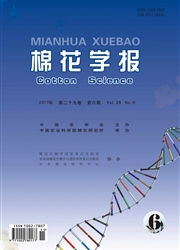

 中文摘要:
中文摘要:
以2个转Bt基因抗虫棉,泗抗1号(常规种)、泗抗3号(杂交种)为材料,研究了低温对转Bt基因抗虫棉叶片中杀虫蛋白表达量和氮代谢的影响。2007年,于盛蕾期、盛花期、盛铃期,将盆栽棉花18cc低温下处理24h。2008年.在18℃低温下处理48h。研究结果表明,低温胁迫显著降低转Bt基因抗虫棉品种叶片中杀虫蛋白表达量。但盛铃期,下降幅度最大。其中低温胁迫24h后,泗抗1号下降23.7%,泗抗3号下降28.1%;低温胁迫48h后.2个品种分别下降52.9%和47.6%。叶片中丙酮酸转氨酶(GPT)活性、游离氨基酸、可溶性蛋白含量与蛋白酶活性在低温胁迫下表现相同趋势。以上结果表明,低温可能导致叶片可溶性蛋白的合成量降低,从而导致杀虫蛋白表达水平的下降。但对可溶性蛋白的分解并未有明显影响。
 英文摘要:
英文摘要:
We investigated the effects of low temperature on nitrogen metabolism and the content of the insecticidal protein CryI- Ac in the leafofBt transgenic cotton. This study was undertaken on two transgenic cotton cultivars, one conventional (Sikang I) and the other a hybrid (Sikang 3). In the 2007 growing season, potted cotton plants were exposed to 18 ~C for 24 hours under glasshouse conditions at three growth stages: peak square, flowering, and peak boll development. In the 2008 growing season, plants of the same two cultivars were exposed to the same temperature for 48 hours at three growth stages. The results showed that the CrylAc content of the leaf was significantly affected by the temperature stress during the three periods. However, the re- duced extent CrylAc content was the greatest from exposure to low temperature at the peak boll period. Glutamic-pyruvic transaminase activity, total flee amino acids, soluble protein content, and protease activity in the leaf showed similar changes of reduction in response to low temperature. These parameters decreased most at the peak boll period as well. The results suggest that low temperature may result in the reduction of soluble protein synthesis in the leaf, with a resulting decline in the level of CrylAc. It is believed that this may be the cause of the reduced efficacy of Bt cotton in typical growing conditions, where tem- peratures during the cotton growth season often decrease by 15-20℃. The results suggest that low temperature may result in the reduction of soluble protein synthesis in the leaf, with a resulting decline in the level of the toxin CrylAc.
 同期刊论文项目
同期刊论文项目
 同项目期刊论文
同项目期刊论文
 The Effects of the relative humidity on the insecticidal expression level of Bt Cotton during bollin
The Effects of the relative humidity on the insecticidal expression level of Bt Cotton during bollin 期刊信息
期刊信息
